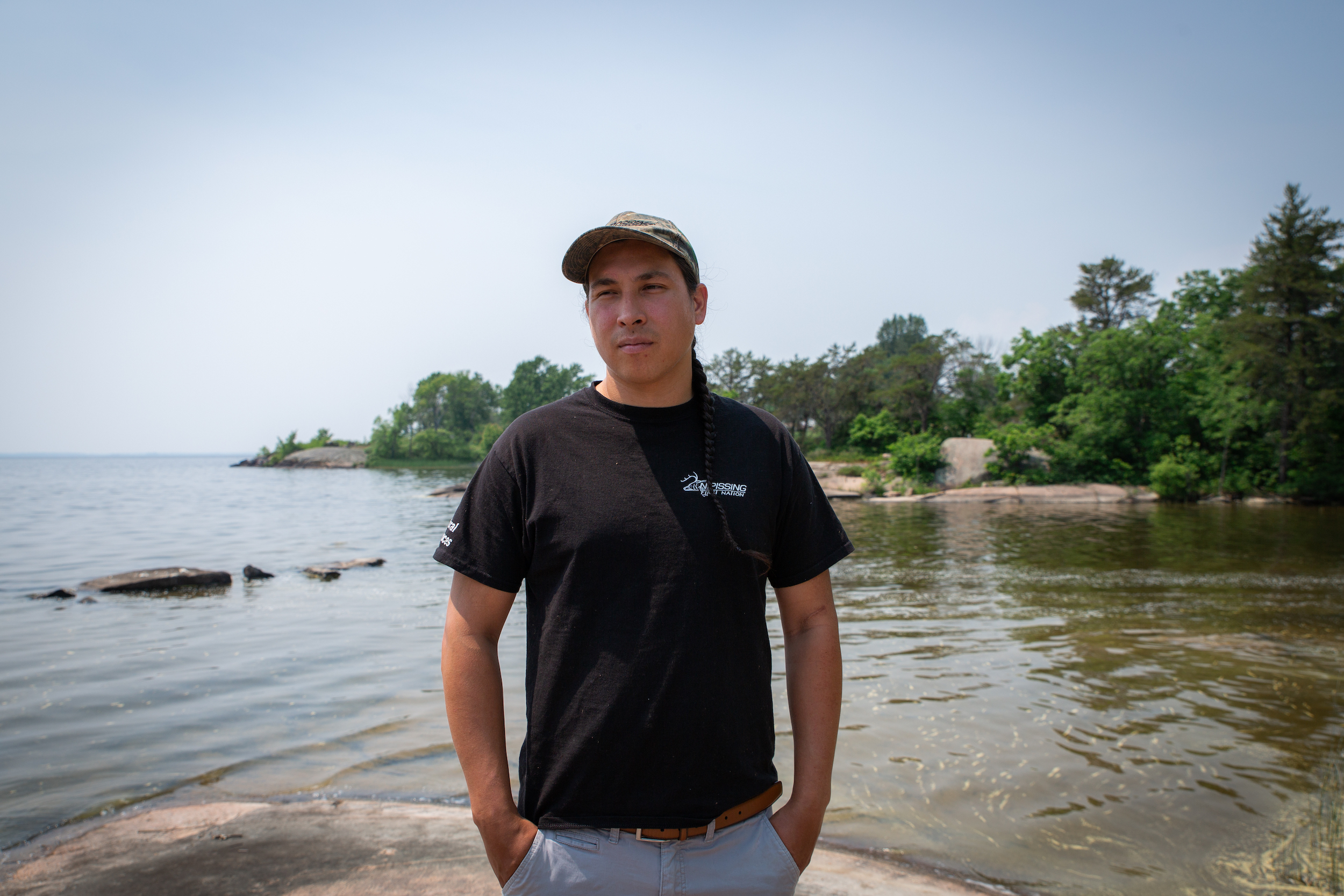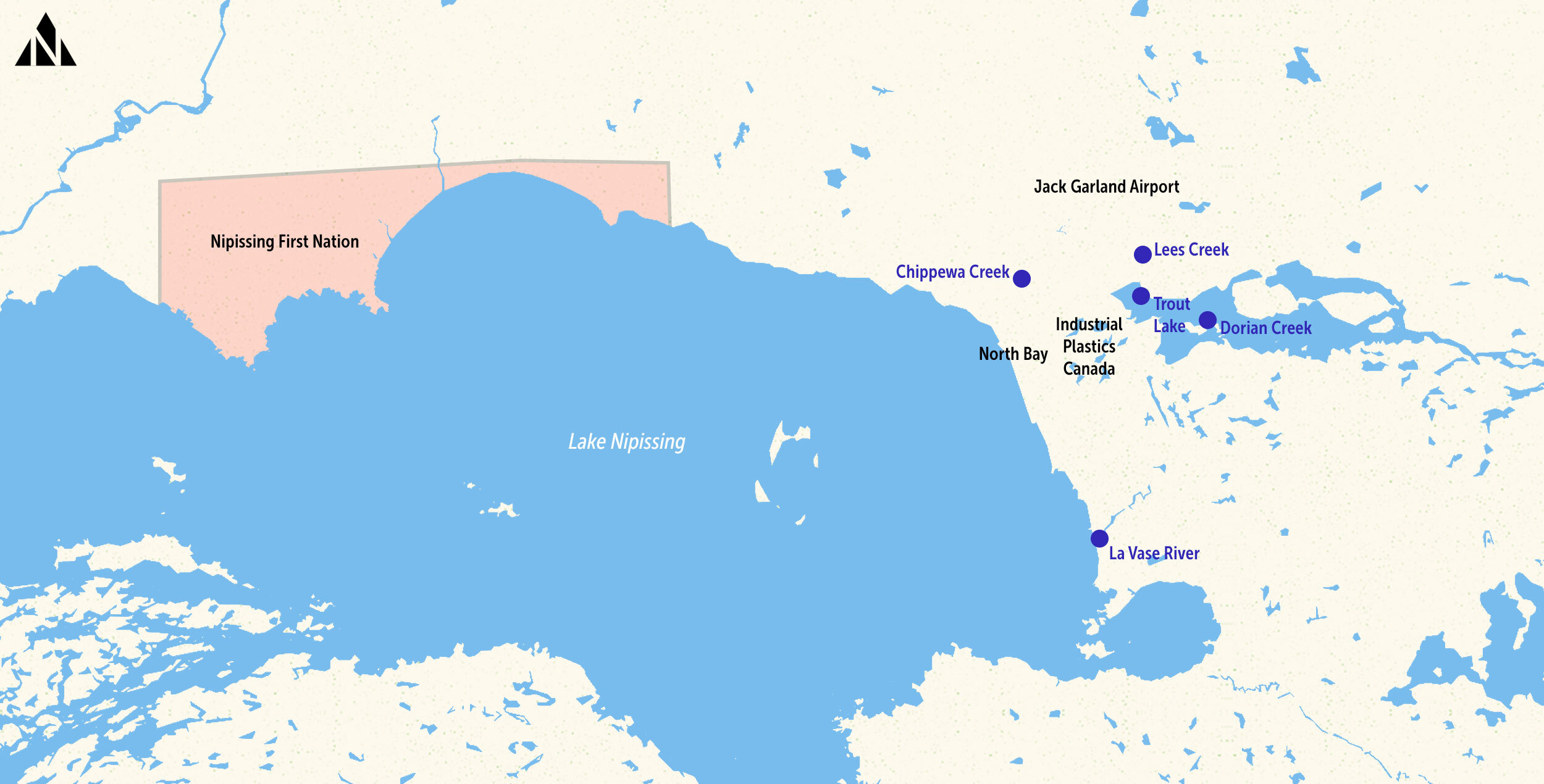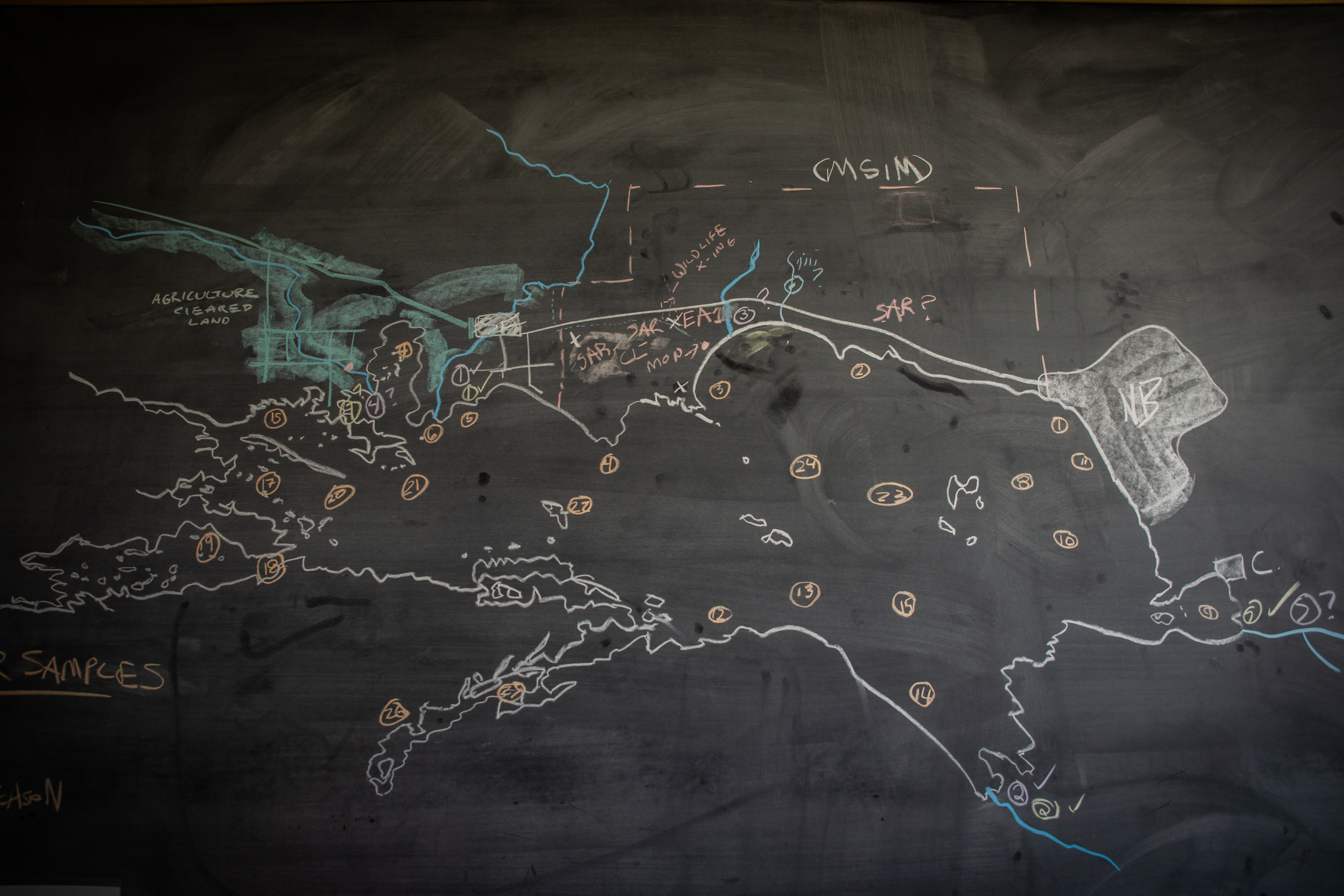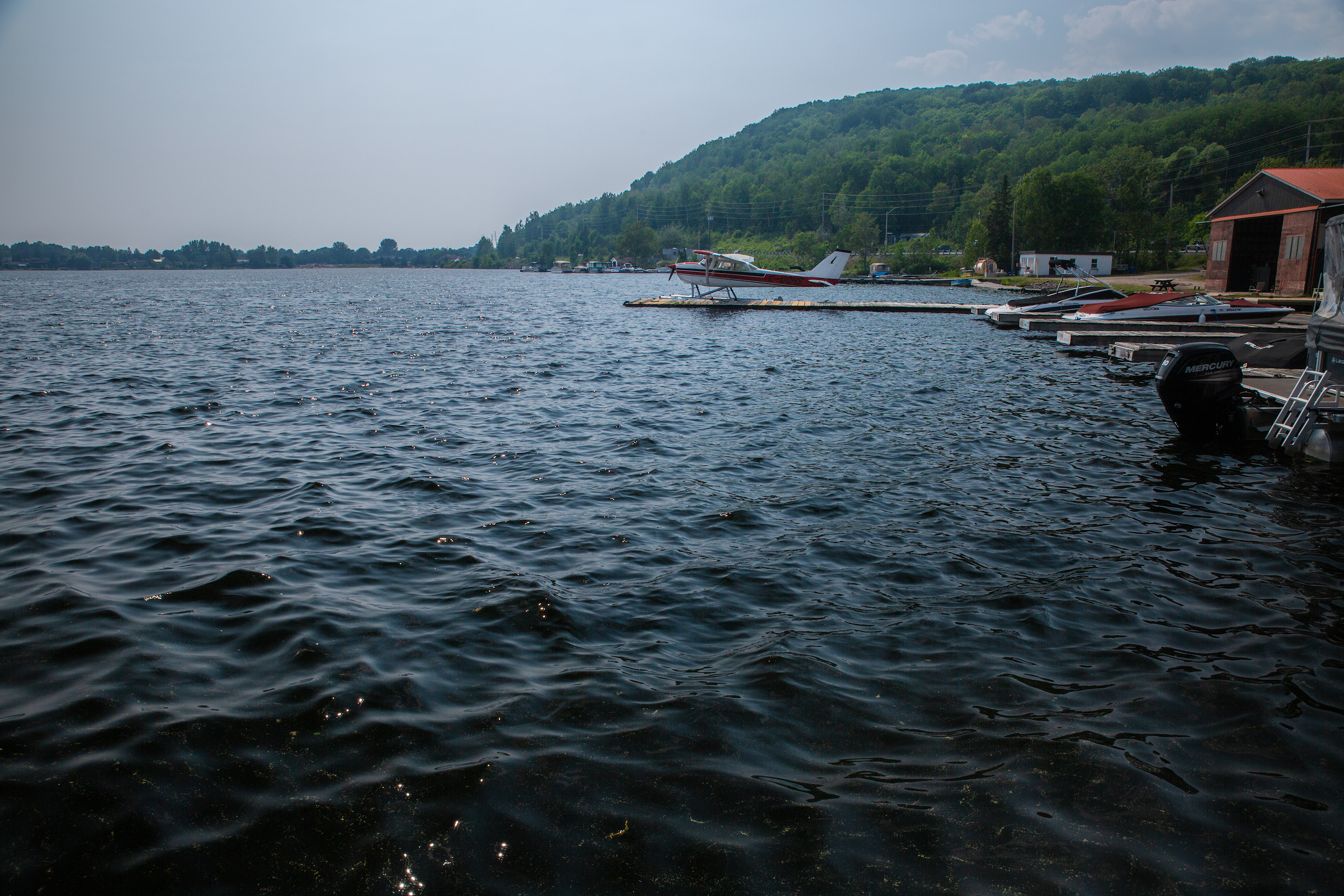ONTARIO
Chemicals are forever: a new factory opens near Lake Nipissing, where water is already contaminated
Industrial Plastics Canada's new North Bay factory is set to use fluoropolymers, part of a group of chemicals known as PFAS that Canada has been slow to regulate
The Narwhal
July 6, 2023
July 6, 2023
EXCERPT
VERY LONG READ
Imagine driving down a two-lane road on a sunny day in northeastern Ontario, just east of North Bay’s city centre. To your right, dandelions bloom bright yellow, dotting the lawns of red brick apartments. On your left is Circle Lake, one of the many bodies of water nearby, buzzing with birds and dragonflies. About a kilometre south, you reach the new site of Industrial Plastics Canada, a factory opening in July 2023.
Local news coverage of the opening has been sparse, mostly touting that the plant will bring economic benefits, including up to 35 new jobs to a town with an unemployment rate more than double the national average. Less has been said publicly about the company’s plans to manufacture — or perhaps just use, depending which Industrial Plastics employee is speaking — polytetrafluoroethylene (PTFE), a Teflon-like product that falls into a larger group of chemicals called per- and polyfluoroalkyl substances (PFAS).
PFAS are commonly known as “forever chemicals” because they can generate hazardous waste which, if not disposed of carefully, contaminates air, water and soil where it can remain for about 1,000 years. That there has been little information published about Industrial Plastics’ plans, including a glaring lack of an environmental assessment, is worrying community members.
VERY LONG READ
Imagine driving down a two-lane road on a sunny day in northeastern Ontario, just east of North Bay’s city centre. To your right, dandelions bloom bright yellow, dotting the lawns of red brick apartments. On your left is Circle Lake, one of the many bodies of water nearby, buzzing with birds and dragonflies. About a kilometre south, you reach the new site of Industrial Plastics Canada, a factory opening in July 2023.
Local news coverage of the opening has been sparse, mostly touting that the plant will bring economic benefits, including up to 35 new jobs to a town with an unemployment rate more than double the national average. Less has been said publicly about the company’s plans to manufacture — or perhaps just use, depending which Industrial Plastics employee is speaking — polytetrafluoroethylene (PTFE), a Teflon-like product that falls into a larger group of chemicals called per- and polyfluoroalkyl substances (PFAS).
PFAS are commonly known as “forever chemicals” because they can generate hazardous waste which, if not disposed of carefully, contaminates air, water and soil where it can remain for about 1,000 years. That there has been little information published about Industrial Plastics’ plans, including a glaring lack of an environmental assessment, is worrying community members.

Curtis Avery is environment manager at Nipissing First Nation, on the north shore of Lake Nipissing. “When the manufacturer has byproducts, where do they go?” Avery asked of a new plastics factory set to use PFAS, which is not required to undergo an environmental assessment.
Photo: Vanessa Tignanelli / The Narwhal
“My concern is, usually these areas that have higher levels of PFAS are not only the factories, but the areas around these factories, and where they end up when the consumers are done with the product,” Curtis Avery, environment manager of Nipissing First Nation, told The Narwhal. “When the manufacturer has byproducts, where do they go?”
“These industrial areas are often surrounded by lower income buildings and peoples and communities,” Avery said. “Had they had some information about what’s going on and what it entails with these forever chemicals, I think they’d be concerned too.”
A company spokesman told The Narwhal the use of polytetrafluoroethylene at the factory will not produce waste and poses “no risk.” The company also says fluoropolymers aren’t as dangerous as other per- and polyfluoroalkyl substances and are “considered safe, non-bioaccumulative and non-toxic.”
Thousands of substances classified as per- and polyfluoroalkyl substances are used to make everything from medical equipment to waterproof clothing. Statistics Canada reports almost all Canadians already have PFAS in their bodies, including in remote regions such as the Arctic and subarctic. While Health Canada is in the process of figuring out how to approach a broad range of per- and polyfluoroalkyl substances, it currently only regulates a fraction of those that exist.
The United States Environmental Protection Agency lists potential health risks of exposure including reproductive problems like infertility; developmental effects in children; increased risk of prostate, kidney and testicular cancers; and weakening of the body’s immune system, including reduced vaccine response. The Canadian government says PFAS can be transferred through the placenta during pregnancy and infants and children can be exposed through ingestion of human milk.
Ecosystems are affected, too. Studies have shown exposure to per- and polyfluoroalkyl substances can cause reduced seed germination, stunted growth and reduced photosynthetic activity in plants. The chemicals can then bioaccumulate — build up in the organs of living creatures — in the food chain. In the district of Nipissing, that poses a risk to more than 15 protected areas and the people who live off the land, like Avery’s nation.
“We’re the most vulnerable group of people that utilize our lands — the lands are our grocery stores … if these are being impacted, we need to know,” Avery said.
Especially since the region and its waterways are already coping with forever chemical contamination from decades past.
North Bay is already trying to get forever chemicals out of its drinking water
From the early 1970s to the mid-1990s, the Department of National Defence used a foam containing PFAS to train firefighters across Canada, including near the North Bay Jack Garland Airport. In 2016, after the North Bay Parry Sound District Health Unit learned PFAS had been identified in waterways around the city, a consulting firm called Stantec assessed the impacts in soil and groundwater.
Indeed, Stantec found PFAS from the foam had contaminated surface water, soil, bedrock and groundwater surrounding the site. Forever chemicals had found their way into the municipal drinking water system and private wells, as well as Trout Lake, Lake Nipissing, Lees, Dorlan, Chippewa and La Vase creeks and surrounding areas. In 2020, CBC reported at least 26 National Defence sites had known or suspected PFAS contamination and as many as 420 airports across the country could be a problem as well.

Long-lasting chemicals known as PFAS have contaminated surface water, soil, bedrock and groundwater near the Jack Garland Aiport, including the municipal drinking water system, private wells and waterways around Nipissing District.
Map: Shawn Parkinson / The Narwhal
In Nipissing District, Stantec recommended expanding water sampling in the area, a suggestion echoed in a 2017 report by Dr. Jim Chirico, then-medical officer of health and executive officer for the local health unit. Chirico also recommended remediating the site as soon as possible and regular communication with the community about the state of the water and the site.
But 2017 was the last time the health unit provided an update on the PFAS info page on its website. Five years later, there is still an advisory against drinking or fishing from Lees Creek, which is closest to the contaminated site and drains into other bodies of water. Residents still get their private wells tested regularly.
That’s because all the city has done so far is test the contamination, not remediate it: in 2021, North Bay announced it would fund up to $600,000 of a $20-million study to evaluate water treatment options, with National Defence picking up the rest of the tab. The study got underway in late 2022 and a report was due this spring, but city spokesperson Gord Young told The Narwhal the study isn’t finished yet.
Once it is, council will have to review the report before the public can see it. Sometime after that, remediation can officially begin.
Meanwhile, North Bay residents who develop symptoms related to water contamination may not be able to get a diagnosis — let alone treatment — due to a shortage of doctors in the region. Other small North American towns have seen the effects of leaving such conditions unmonitored and untreated. In 2016, Merrimack, New Hampshire, learned of forever chemical water contamination dating back decades. A community health survey a year later showed higher-than-average incidence of a slew of health concerns, with those under 18, women, industrial workers and longtime residents most likely to be affected. The survey also noted a “critical gap in information” for PFAS-exposed residents without a doctor to guide them.
In Nipissing District, Stantec recommended expanding water sampling in the area, a suggestion echoed in a 2017 report by Dr. Jim Chirico, then-medical officer of health and executive officer for the local health unit. Chirico also recommended remediating the site as soon as possible and regular communication with the community about the state of the water and the site.
But 2017 was the last time the health unit provided an update on the PFAS info page on its website. Five years later, there is still an advisory against drinking or fishing from Lees Creek, which is closest to the contaminated site and drains into other bodies of water. Residents still get their private wells tested regularly.
That’s because all the city has done so far is test the contamination, not remediate it: in 2021, North Bay announced it would fund up to $600,000 of a $20-million study to evaluate water treatment options, with National Defence picking up the rest of the tab. The study got underway in late 2022 and a report was due this spring, but city spokesperson Gord Young told The Narwhal the study isn’t finished yet.
Once it is, council will have to review the report before the public can see it. Sometime after that, remediation can officially begin.
Meanwhile, North Bay residents who develop symptoms related to water contamination may not be able to get a diagnosis — let alone treatment — due to a shortage of doctors in the region. Other small North American towns have seen the effects of leaving such conditions unmonitored and untreated. In 2016, Merrimack, New Hampshire, learned of forever chemical water contamination dating back decades. A community health survey a year later showed higher-than-average incidence of a slew of health concerns, with those under 18, women, industrial workers and longtime residents most likely to be affected. The survey also noted a “critical gap in information” for PFAS-exposed residents without a doctor to guide them.
Nocera repeated more than once that Guarniflon and Industrial Plastics follow all regulations to “meet the necessary safety and efficacy standards.”
“We stay up-to-date on all developments through our corporate departments and initiatives that lead industry research and liaise with government to establish or update safety and environmental standards,” he wrote. He also said the company’s products meet a variety of safety standards, including KTW certification, a German requirement for plastic that comes in contact with drinking water.
But scientific knowledge is full of blank spots in regard to the ever-growing list of the thousands of chemicals classified as per- and polyfluoroalkyl substances and their health effects. And regulatory bodies at every level of Canadian government have been slow to take on the challenge. At present, Health Canada prohibits the manufacture, use, sale, offer for sale and import of only three subgroups of PFAS. And even those prohibitions have exemptions, meaning many are still in circulation.
“Regulatory compliance will always lag behind new science and processes to get chemicals and materials of concern into new restrictions,” Beverley Thorpe, former director of Greenpeace International, told The Narwhal. “The fluoropolymer industry knows that PFAS is now a global concern.”
The European Union’s chemicals agency wants to label the many thousands of per- and polyfluoroalkyl substances as a single class of chemicals and ban them, which could alter one of the safety standards Nocera said the company currently meets. Health Canada is also figuring out “an approach to address PFAS as a class in Canada,” spokesperson Joshua Coke told The Narwhal via email.
“That is why the fluoropolymer industry is fighting hard to be exempt from within any class-based approach,” Thorpe said. European lobbying has been documented extensively in “The Forever Pollution Project,” a collaboration between 18 newsrooms on the continent that included a map of thousands of sites where PFAS are known to exist, including Mazza Holding’s Italian, Romanian and French factories.

Curtis Avery samples water at sites on Lake Nipissing associated with species at risk. Health Canada is currently considering how to “approach PFAS as a class”: a recent draft report proposes all of the chemicals are toxic to the environment and human health. Photo: Vanessa Tignanelli / The Narwhal
In May, Health Canada issued a draft report on per- and polyfluoroalkyl substances two years in the making that proposes all substances in the class of PFAS are toxic to the environment and human health, including fluoropolymers like PTFE. If this holds in the final report, which Coke said will come “as quickly as possible,” the government will develop “risk management options.”
Coke said the entire life cycle of the chemicals is being considered. When asked if industry had been lobbying the department, Health Canada said only that public consultation is open until July 19.
De Leon said “class-based” regulatory steps are necessary, but also won’t solve existing contamination.
“The problems associated with these chemicals are ongoing,” de Leon said. “You can turn off the tap on its use or its production, [but] because many of these chemicals have been used in thousands of products, you are going to have to deal with them from a life cycle approach because they are ultimately released into the environment and eventually … end up in waste. That’s where a lot of the evidence is starting to show the presence of those types of chemicals in our environment.”
In some ways, Health Canada’s draft report is already behind — it says there are “more than 4,700 substances” that fit the definition of PFAS, while De Leon said her organization works with 12,000 types and counting. “But the federal government has a really important role,” she said. “The fact that they’ve designated these chemicals as being problematic is key.”
One task for Health Canada is setting an acceptable level of per- and polyfluoroalkyl substances in drinking water, measured in nanograms per litre. As part of its current process, the department published a “draft objective” level of 30 nanograms per litre in February. That’s less than half of what Ontario currently recommends: 70 nanograms per litre for just 11 different PFAS, and that’s just a suggestion, not a binding regulation.
North Bay’s drinking water was 60 nanograms per litre in April 2023 according to Young, who said testing is done quarterly. He expects it could take up to a year before Health Canada’s draft is finalized, and new rules come into play.
In May, Health Canada issued a draft report on per- and polyfluoroalkyl substances two years in the making that proposes all substances in the class of PFAS are toxic to the environment and human health, including fluoropolymers like PTFE. If this holds in the final report, which Coke said will come “as quickly as possible,” the government will develop “risk management options.”
Coke said the entire life cycle of the chemicals is being considered. When asked if industry had been lobbying the department, Health Canada said only that public consultation is open until July 19.
De Leon said “class-based” regulatory steps are necessary, but also won’t solve existing contamination.
“The problems associated with these chemicals are ongoing,” de Leon said. “You can turn off the tap on its use or its production, [but] because many of these chemicals have been used in thousands of products, you are going to have to deal with them from a life cycle approach because they are ultimately released into the environment and eventually … end up in waste. That’s where a lot of the evidence is starting to show the presence of those types of chemicals in our environment.”
In some ways, Health Canada’s draft report is already behind — it says there are “more than 4,700 substances” that fit the definition of PFAS, while De Leon said her organization works with 12,000 types and counting. “But the federal government has a really important role,” she said. “The fact that they’ve designated these chemicals as being problematic is key.”
One task for Health Canada is setting an acceptable level of per- and polyfluoroalkyl substances in drinking water, measured in nanograms per litre. As part of its current process, the department published a “draft objective” level of 30 nanograms per litre in February. That’s less than half of what Ontario currently recommends: 70 nanograms per litre for just 11 different PFAS, and that’s just a suggestion, not a binding regulation.
North Bay’s drinking water was 60 nanograms per litre in April 2023 according to Young, who said testing is done quarterly. He expects it could take up to a year before Health Canada’s draft is finalized, and new rules come into play.

In 2021, North Bay announced it would fund up to $600,000 of a $20-million study to evaluate water treatment options for waterways contaminated with forever chemicals. National Defence is picking up the rest of the tab.
Photo: Vanessa Tignanelli / The Narwhal
Federal drinking water guidelines are set in collaboration with provinces and territories, which then set regulations — currently, only British Columbia and Ontario have any kind of regulatory framework for the forever chemicals in drinking water. Municipalities are left to do the actual monitoring, with the federal government responsible for First Nations’ water quality.
That leaves North Bay positioned to face new regulations even as it still needs to clean up significant existing contamination.
“In North Bay, for a number of years, they not did not want to focus on PFAS. They knew that there was some evidence showing it as a problem, but they didn’t know what their role was,” de Leon said. With contamination a problem across the country, she said many are watching how the city copes. “Because of the public pressure, the public health unit had to engage but that’s not the case with every community that may be facing the same problem.”
Meanwhile, as the Industrial Plastics factory opens, it looks like the region home to Nipissing First Nation and North Bay have forever chemicals in its past, present — and foreseeable future.
Federal drinking water guidelines are set in collaboration with provinces and territories, which then set regulations — currently, only British Columbia and Ontario have any kind of regulatory framework for the forever chemicals in drinking water. Municipalities are left to do the actual monitoring, with the federal government responsible for First Nations’ water quality.
That leaves North Bay positioned to face new regulations even as it still needs to clean up significant existing contamination.
“In North Bay, for a number of years, they not did not want to focus on PFAS. They knew that there was some evidence showing it as a problem, but they didn’t know what their role was,” de Leon said. With contamination a problem across the country, she said many are watching how the city copes. “Because of the public pressure, the public health unit had to engage but that’s not the case with every community that may be facing the same problem.”
Meanwhile, as the Industrial Plastics factory opens, it looks like the region home to Nipissing First Nation and North Bay have forever chemicals in its past, present — and foreseeable future.
READ THE WHOLE ARTICLE
No comments:
Post a Comment